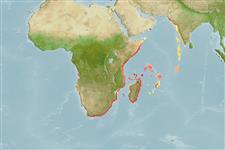Common names from other countries
Environment: milieu / climate zone / depth range / distribution range
ນິເວດວິທະຍາ
ສັດທະເລ; ນ້ຳຈືດ; ນ້ຳກ່ອຍ ອາໄສຢູ່ໃກ້ໜ້າດິນໃຕ້ພື້ນທ້ອງນ້ຳ; ກຸ່ມປາຫຼຊະນິດປາທີ່ມີການເຄື່ອນຍ້າຍຈາກແມ່ນ້ຳລົງສູ່ທະເລເພື່ອວ່າງໄຂ່ (Ref. 51243). Tropical; 25°N - 35°S
Western Indian Ocean: east coast rivers of Africa from Kenya south to Cape Agulhas, also in Madagascar and other western Indian Ocean islands (Ref. 7248, 52193). Reported from New Caledonia (Ref. 11889).
ຂະໜາດ / ນ້ຳໜັກ / Age
Maturity: Lm ? range ? - ? cm
Max length : 150 cm TL ຕົວຜູ້/ບໍ່ມີເພດ; (Ref. 3506); 120.0 cm SL (female); ນ້ຳໜັກສູງສຸດທີ່ເຄຍຈັດພີມມາ: 5.7 kg (Ref. 52193); ນ້ຳໜັກສູງສຸດທີ່ເຄຍຈັດພີມມາ: 5.7 kg; ອາຍຸສູງສຸດທີ່ເຄຍລາຍງານມາ: 20 ປີ (Ref. 48660)
ຄີ (ໜາມ)ແຂງຢູ່ຫຼັງປາ (ທັງໝົດ) : 0; ຄີ(ໜາມ) ແຂງຢູ່ຄີກົ້ນປາ
ກຸ່ມປາກະດູກແຂງ
ຄວາມຖີ່ຂອງກຸ່ມຖ່າຍທອດພັນ
ປາທີ່ມີການເຄື່ອນຍ້າຍຈາກທະເລໄປຫານ້ຳຈືດ ແລະນ້ຳຈືດຫາທະເລ
ປາທີ່ມີການເຄື່ອນຍ້າຍຈາກທະເລແລະໄປໄຂ່ຢູ່ນ້ຳຈືດ
ຄີກົ້ນຂອງປາ
ສັດທີ່ມີກະດູກສັນຫັຼງ
ການຖ່າຍທອດທາງກຳມະພັນຈາກພໍ່ແມ່ຫາລູກ: 0.
Migratory species, which breeds in the ocean (Ref. 52331). Inhabits both quiet and fast flowing water (Ref. 13337). Elvers ascend rivers mainly at night and overcome waterfalls and walls of dams with great determination. Adults usually sedentary. Females can attain 120 cm SL and are generally longer and heavier than males (Ref. 48660). Carnivorous, eats dead or living prey but especially fish and crabs. After feeding in fresh water for ten years or more, adults assume a silver breeding dress, the eyes become enlarged and they return to sea to breed. Considered to breed east of Madagascar, but thought to move south of that island on its way to the Mozambique coast and South African rivers (Ref. 13337). Flesh fatty but highly esteemed as smoked or jellied eel (Ref. 5214). Caught with various types of nets (Ref. 4967).
Life cycle and mating behavior
Maturities | ການສືບພັນ | Spawnings | Egg(s) | Fecundities | ຕົວອ່ອນ
Castle, P.H.J., 1984. Anguillidae. p. 34-37. In J. Daget, J.-P. Gosse and D.F.E. Thys van den Audenaerde (eds.) Check-list of the freshwater fishes of Africa (CLOFFA). ORSTOM, Paris and MRAC, Tervuren. Vol. 1. (Ref. 3506)
IUCN Red List Status (Ref. 130435)
CITES (Ref. 128078)
Not Evaluated
Threat to humans
Harmless
Human uses
ການປະມົງ: ເປັນສີນຄ້າ; ການລ້ຽງສັດນ້ຳ: ເປັນສີນຄ້າ; ຊະນິດປາທີ່ຖືກນຳໃຊ້ເຂົ້າໃນການຫາເພື່ອເປັນເກມກິລາ: ແມ່ນ
ເຄື່ອງມື
Special reports
Download XML
ແຫຼ່ງອີນເຕີເນັດ
Estimates based on models
Preferred temperature (Ref.
115969): 19.6 - 27.5, mean 26.4 (based on 98 cells).
Phylogenetic diversity index (Ref.
82804): PD
50 = 0.5000 [Uniqueness, from 0.5 = low to 2.0 = high].
Bayesian length-weight: a=0.00089 (0.00051 - 0.00156), b=3.20 (3.05 - 3.35), in cm Total Length, based on LWR estimates for this species & Genus-body shape (Ref.
93245).
ຊັ້ນເຂດຮ້ອນ (Ref.
69278): 3.3 ±0.55 se; based on food items.
ຄວາມຢືດຢຸ່ນ (Ref.
120179): ຕຳ່ຫຼາຍ, ປະຊາກອນຕຳ່ສຸດທີ່ໃຊ້ເວລາສອງເທົ່າຫຼາຍກວ່າ 14 ປີ (K=0.04).
Fishing Vulnerability (Ref.
59153): Very high vulnerability (81 of 100).
